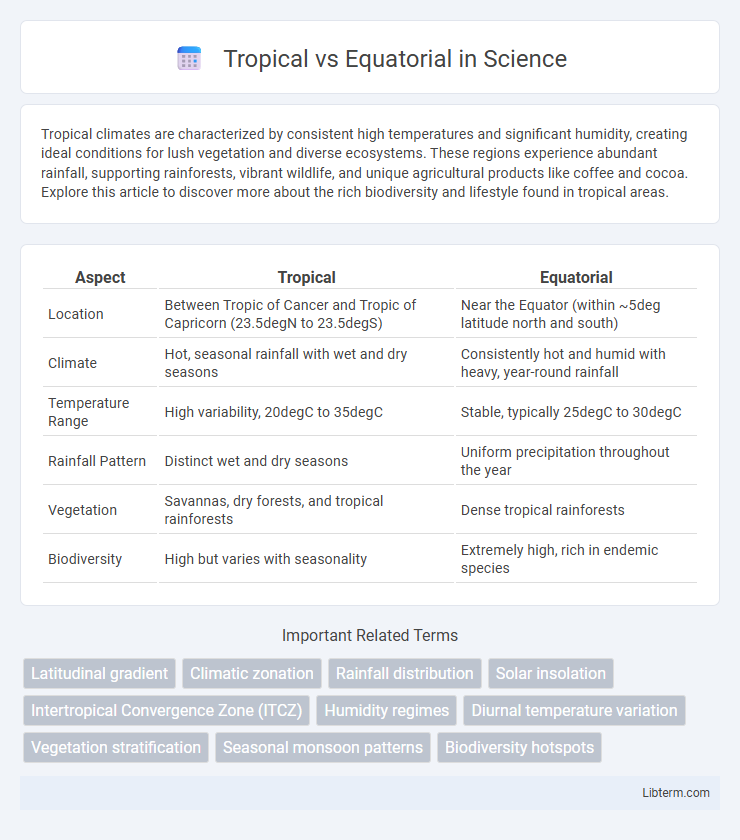Tropical climates are characterized by consistent high temperatures and significant humidity, creating ideal conditions for lush vegetation and diverse ecosystems. These regions experience abundant rainfall, supporting rainforests, vibrant wildlife, and unique agricultural products like coffee and cocoa. Explore this article to discover more about the rich biodiversity and lifestyle found in tropical areas.
Table of Comparison
| Aspect | Tropical | Equatorial |
|---|---|---|
| Location | Between Tropic of Cancer and Tropic of Capricorn (23.5degN to 23.5degS) | Near the Equator (within ~5deg latitude north and south) |
| Climate | Hot, seasonal rainfall with wet and dry seasons | Consistently hot and humid with heavy, year-round rainfall |
| Temperature Range | High variability, 20degC to 35degC | Stable, typically 25degC to 30degC |
| Rainfall Pattern | Distinct wet and dry seasons | Uniform precipitation throughout the year |
| Vegetation | Savannas, dry forests, and tropical rainforests | Dense tropical rainforests |
| Biodiversity | High but varies with seasonality | Extremely high, rich in endemic species |
Introduction to Tropical and Equatorial Regions
Tropical regions, located between the Tropic of Cancer and Tropic of Capricorn, are characterized by distinct wet and dry seasons with high temperatures year-round. Equatorial regions, centered around the equator, experience consistent high humidity and rainfall, leading to dense rainforests and minimal seasonal variation. Both zones are crucial for biodiversity but differ in climate patterns and atmospheric dynamics.
Geographic Location and Boundaries
Tropical regions lie between the Tropic of Cancer at approximately 23.5degN and the Tropic of Capricorn at approximately 23.5degS, encompassing vast areas across continents and oceans. Equatorial zones are situated along the equator, roughly between 5degN and 5degS, characterized by consistently high temperatures and humidity year-round. The tropical climate extends beyond the narrow equatorial belt, covering larger geographic boundaries with greater variation in precipitation patterns.
Climate Differences: Temperature and Rainfall
Tropical climates exhibit a wider temperature range with distinct wet and dry seasons, averaging between 25degC and 30degC, while equatorial climates maintain consistently high temperatures near 27degC year-round. Rainfall in tropical regions often varies seasonally, ranging from 1,000 to 3,000 mm annually, compared to the equatorial belt, which experiences heavy, evenly distributed rainfall exceeding 2,000 mm each year. The tropical climate supports diverse ecosystems adapted to fluctuating moisture levels, whereas the equatorial climate sustains dense, evergreen rainforests due to its constant humidity and precipitation.
Distinct Seasons: Wet vs Dry
Tropical climates typically experience distinct wet and dry seasons, with a pronounced dry period lasting several months and a wet season characterized by heavy rainfall. Equatorial climates, in contrast, have minimal seasonal variation, maintaining consistently high rainfall and humidity year-round without a true dry season. This difference in precipitation patterns significantly influences vegetation, agriculture, and water resource management in these regions.
Biodiversity and Ecosystems
Tropical regions and equatorial zones both exhibit extraordinary biodiversity, but tropical forests often contain a wider variety of ecosystems, including rainforests, savannas, and dry forests, supporting diverse flora and fauna adapted to distinct microclimates. Equatorial areas, characterized by consistent high rainfall and temperatures, foster dense, evergreen rainforests with some of the richest species diversity on Earth, such as the Amazon Basin and Congo Basin. These ecosystems play critical roles in carbon sequestration, water cycling, and habitat provision, highlighting their global ecological importance.
Key Differences in Flora and Fauna
Tropical regions feature diverse flora such as broadleaf evergreens and a variety of fruit trees, supporting fauna like monkeys, parrots, and butterflies adapted to seasonal wet and dry periods. Equatorial zones exhibit dense rainforests with consistent high rainfall, hosting specialized species like orangutans, hornbills, and numerous amphibians thriving in stable, humid environments. These ecosystems differ primarily in rainfall patterns, leading to distinct vegetation structures and animal adaptations suited for seasonal versus constant moisture availability.
Human Settlements and Cultural Adaptations
Human settlements in tropical regions often adapt to seasonal rainfall and temperature variations by developing agricultural practices such as shifting cultivation and building stilt houses to manage flooding. In equatorial zones, dense rainforests and consistent high humidity influence communities to rely on diverse subsistence strategies, including hunting, gathering, and agroforestry, while constructing homes with materials that promote ventilation and protect from heavy rain. Cultural adaptations also reflect these environmental challenges, with social structures and traditions centered around resource management and resilience to climate conditions.
Economic Activities: Agriculture and Tourism
Tropical regions excel in agriculture with crops like sugarcane, coffee, and cocoa thriving due to warm temperatures and seasonal rainfall, supporting export economies and local livelihoods. Equatorial zones, characterized by consistent rainfall and humidity, sustain dense rainforests that limit large-scale farming but promote small-scale, diverse crop cultivation and rich biodiversity tourism. Tourism in tropical areas often centers on beach resorts and seasonal festivals, while equatorial regions attract eco-tourists with rainforests, wildlife sanctuaries, and adventure expeditions.
Environmental Challenges and Conservation
Tropical regions often face challenges such as deforestation, habitat loss, and biodiversity decline due to extensive agricultural expansion and urbanization, whereas equatorial zones experience high humidity and temperature that promote rich ecosystems but are vulnerable to climate change-induced alterations in rainfall patterns. Conservation efforts in tropical areas focus on sustainable land management and protecting endangered species, while equatorial conservation emphasizes preserving primary forests and mitigating the impacts of carbon emissions. Both regions require integrated strategies involving reforestation, community engagement, and strict enforcement of environmental laws to maintain ecological balance.
Summary: Tropical vs Equatorial Regions
Tropical regions lie between the Tropic of Cancer and Tropic of Capricorn, characterized by distinct wet and dry seasons with temperature variations influenced by altitude and proximity to oceans. Equatorial regions, located around the equator, experience consistent high temperatures and heavy rainfall year-round, resulting in dense tropical rainforests with minimal seasonal change. Both regions support diverse ecosystems but differ primarily in rainfall patterns and seasonal temperature stability.
Tropical Infographic

 libterm.com
libterm.com